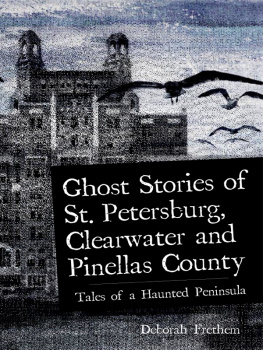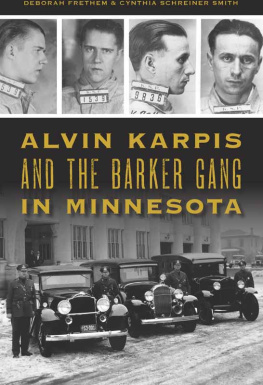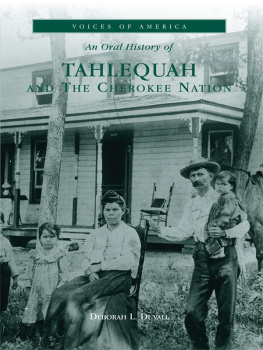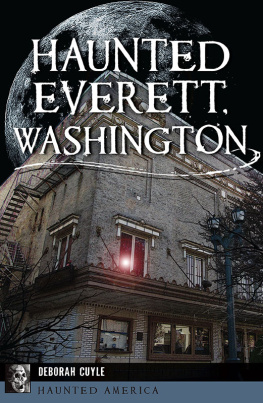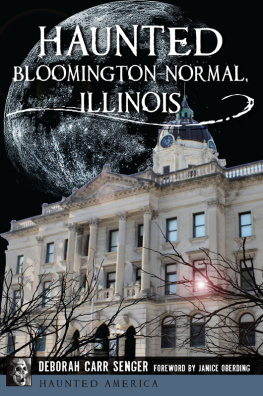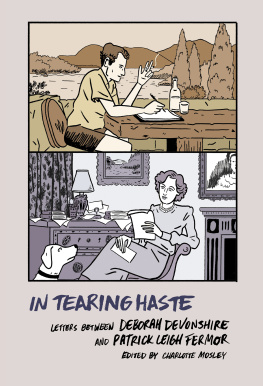Published by Haunted America
A Division of The History Press
Charleston, SC 29403
www.historypress.net
Copyright 2014 by Deborah Frethem
All rights reserved
First published 2014
e-book edition 2014
ISBN 978.1.62585.149.9
Library of Congress CIP data applied for.
print edition ISBN 978.1.62619.622.3
Notice: The information in this book is true and complete to the best of our knowledge. It is offered without guarantee on the part of the author or The History Press. The author and The History Press disclaim all liability in connection with the use of this book.
All rights reserved. No part of this book may be reproduced or transmitted in any form whatsoever without prior written permission from the publisher except in the case of brief quotations embodied in critical articles and reviews.
Dedicated to all the people who told me I couldnt do it. And to all the people who believed I could. Most especially to Craig, who never waivers and who knows when to cajole and when to be stern. And to Signe, who calls me Bubba and kept asking, When will your book be finished?
Introduction
THE BEGINNING OF A DREAM
Tampa was in trouble.
The little Florida settlement that had shown such promise in the first half of the nineteenth century was not doing well at the end of the Civil War. Malaria and yellow fever, hurricanes and war had all taken their toll. By 1885, the population had dropped from over one thousand to less than four hundred people. Some settlers had departed during the Civil War and never returned. Others had succumbed to the yellow fever epidemics that ravaged the area several times after 1850. The U.S. Army post, Fort Brooke, had been decommissioned in 1883. Even getting to Tampa was a challenge. It was either a long, uncomfortable stagecoach ride from Gainesville or an unreliable boat service over rough seas from Key West or Cedar Key. There was a strong possibility that Tampa would never recover. One historian called the 1870s the dismal decade.
But two things happened to change all that. The first was the coming of a railroad, brought to Tampa by Henry B. Plant. Born in Connecticut in 1809, Henry grew up in the steamship era. As a young man, his grandmother offered to pay for him to be educated at Yale, but he turned down her offer. He wanted to learn the shipping business from the waterline up. He signed on as a deckhand on a steamship and worked his way to the top. He became an expert at moving cargo accurately and efficiently from place to place and quickly came to understand the value of rail transportation, expanding his business accordingly.
Elevated view of Tamp Box Company. This is where the cigar boxes were made. The building still stands and is being turned into apartments today. Courtesy Tampa-Hillsborough Public Library System.
Henry married in 1842 and had two sons, but his wife, Ellen Elizabeth, was often ill. A doctor suggested that she might do better in a warmer climate, so they spent some time in Jacksonville, Florida. The weather did seem to have recuperative powers for Ellen, but upon their return to the North, she once again fell ill, dying in 1861.
Distraught, Henry threw himself into his work. Despite his Connecticut background, he formed the Southern Express Company, which provided rail service to the Confederacy during the Civil War. His trains carried not only packages but also messages and money. And perhaps most importantly, they shipped home the bodies of the Confederate dead from the far-off battlefields. Many a Southern mother could actually bury her son in the family graveyard because of Henry B. Plant.
After the war, Henry used his connections to acquire the damaged and nearly destroyed railroads throughout the South, merging them into a new transportation system that made him a wealthy man. In 1883, phosphate, a mineral used to make fertilizer, was discovered in large amounts just southeast of Tampa. Henry Plant knew a moneymaking opportunity when he saw one, and he expanded his operation to include Tampa in 1884. But his rails did more than carry phosphate out of Florida. He also built two small hotels (both of which are long gone) and began to promote Tampa as a tourist destination. That way, his trains could carry passengers as well as freight. A few years later, in 1891, he would build the magnificent Tampa Bay Hotel, which is part of the University of Tampa today. Its silver domes and minarets are the symbol of Tampa.
But even a railroad was clearly not enough. The Bank of Tampa, the only such financial institution in the area, was packing up and getting ready to leave.
The second serendipitous occurrence that saved Tampa was the arrival of the cigar-making industry. And this almost didnt happen.
There were already cigar factories in the United States in New York and Key West. But the locations were not ideal, and several factory owners were looking for new sites. It was in 1884 that Gavino Gutirrez, a Spaniard by birth, accompanied his friend, Bernardino Grgol, a Cuban who ran an import business in New York City, to the Tampa Bay area in search of native guava trees in the hopes of increasing the manufacture of his most successful item, jellies and preserves made from the tropical fruit. Unfortunately, their search proved fruitless (no pun intended), and no guava trees were found. But Gutirrez, who was familiar with several cigar makers, was very impressed with Tampa as a future cigar manufacturing area. The climate was ideal. Believe it or not, the humidity was a good thing for tobacco. Plants new railroad allowed for easy shipping. And most important, the proximity to the tobacco fields of Cuba made importation of fine tobacco simple.
Gutirrez contacted some other friendsIgnacio Haya and Vicente Martnez de Yborand encouraged them to come and look at this perfect location.
Ybor arrived in 1885 and found what he considered to be an ideal spot, forty acres northeast of Tampa. The land was owned by Captain John T. Leslie, a local pioneer and Civil War hero. Leslie wanted $9,000 to sell the property; Ybor only wanted to pay $5,000. Normally, this would have provided an opportunity for negotiations, but in this case, both men held firm, neither one budging on his price by so much as a dollar. Things were looking bleak, and Ybor prepared to leave Tampa to go to Galveston. (The Texas city was also courting Ybor and the others to establish their business there.)




